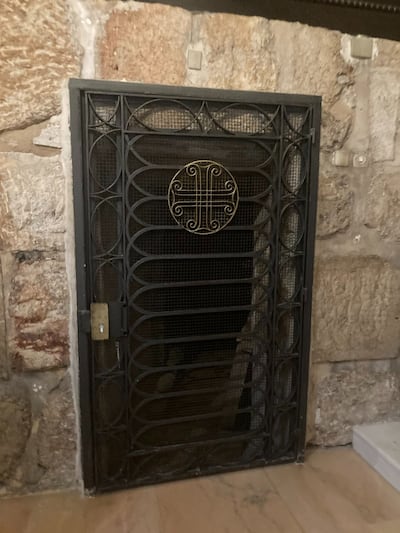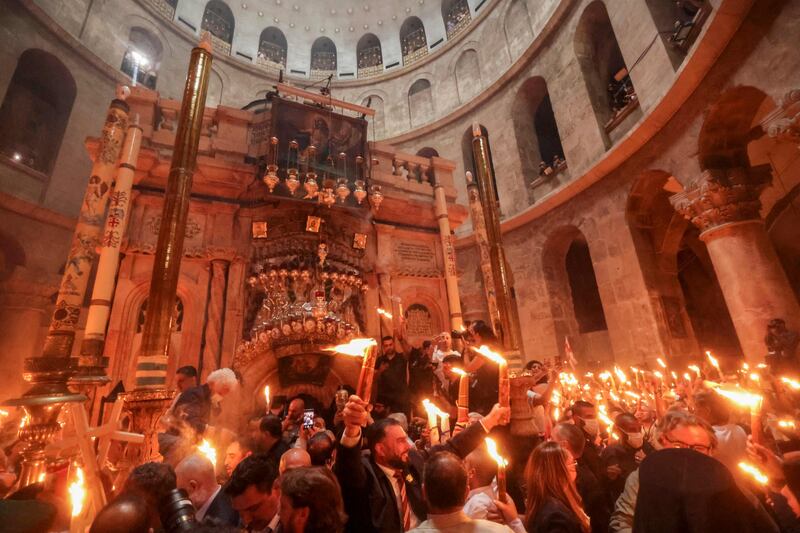
“Domine Ivimus”, or in English, “Lord we shall go”.
This is the triumphant written proclamation made by a Christian pilgrim who came to Jerusalem’s Church of the Holy Sepulchre by boat from somewhere in Mediterranean Europe almost 2,000 years ago.
The pilgrim, arriving at the site where some believe Jesus Christ was buried after crucifixion, also sketched a detailed picture of the vessel that brought him to the Holy Land. It is majestic, but not one in which you would want to cross oceans.
There is a lot of religious graffiti at the site of the Holy Sepulchre. The Roman-era Christian’s maritime example is believed to be the oldest.
It also is arguably the most important in the church. The picture allowed academics to say with greater certainty that today's Holy Sepulchre is indeed Jesus Christ's earthly resting place.
“What does this boat and text prove? The very fact that the Holy Sepulchre is here. Because it shows that early Christians came secretly to worship here as far back as the second century,” George Hintlian, a historian, told The National.

The wall on which the graffiti is found is from a pagan temple. “The Romans built it to cover up the fact that this was the Holy Sepulchre,” Mr Hintlian says. “Paradoxically, by building a temple here, they helped to prove the significance of the site.”
The inscription was found in the 1970s, when an Armenian archimandrite priest, Guregh Kapikian, embarked on a fruitful and controversial excavation, which, despite protestations from his community, eventually unearthed an entire chapel.
For the Armenians, the project was divisive mostly because of the cost. “My father was in charge of administration when Kapikian dug here. There were thousands of tonnes of wet earth,” Mr Hintlian says. “It cost us roughly $3.5 million. Critics were angry, accusing the bishop of throwing their money into a mere cave. Kapikian suffered, he was even, let’s say, persecuted.”
The project could also have outraged the other Christian denominations that share custodianship of the church with the Armenians. Throughout history, the factions have often come to blows over the site’s territory and governance.
“Our poor archimandrite was only able to take out four baskets of earth at a time, so that the Greeks and Latins wouldn’t see him removing it from the church. What a punishment,” Mr Hintian says.
“There was another danger in the excavation,” he adds. “On top of us are the Ethiopian Christians. They have their hovels above. As this was wet earth, the fear was that one night they would come crashing through the roof. So we quickly supported it with iron beams.”
As Mr Hintlian delivered his lecture, two tourists saw that the entrance was open and managed to find their way down the stairs that are normally closed. They were extremely lucky to do so. Today, despite its potentially huge significance, seeing the Chapel of the Boat is a rare privilege. Only the Armenian clergy have the key to an unassuming metal door next to the 12th-century Chapel of Saint Helena, which leads down into the small room, surrounded by a deep cave.

But if you are able to convince the community to let you in, what awaits is something special. The space, unlike the rest of the church, is quiet.
It could also be an extremely significant stop for pilgrims, not just historians. Some have argued that it is the actual site of Calvary, where Christ was crucified.
Mr Hintlian says that is why some journalists and filmmakers are so keen to visit.
“The present Calvary is very Renaissance,” Mr Hintlian says. “But in here, if you play with the lights, you feel that something special and mysterious happened. That is why some films on the Holy Sepulchre start here. They can make the case that in this quiet chamber is the real Calvary. Just don’t look down.”

The inscription is also a chance to appreciate the struggle pilgrims have made for hundreds of years for their faith.
Almost 2,000 years later the kind of religious determination shown by the sea-travelling visitor is still etched on the faces of Christian pilgrims in the church today, because while a visit to the Holy Sepulchre might be profoundly moving, it is hardly relaxing.
Arriving by boat might be less common, but today’s worshippers still have to embark on a long and costly journey to Jerusalem, most often via the security-heavy Ben-Gurion airport.
Once in the city, they must make their way through the confusing ancient streets of the Christian Quarter.
Only then do they get to the packed stairs of the church’s courtyard, from which they then need to push past numerous tour groups.
Once in, passion, politics and a lot of queues are immediately in store.
At the very entrance is the Stone of Unction, believed to be the site where Christ's body was laid before his burial. Knelt over it will be pilgrims from all over the world, praying in many languages.
The National saw several Ukrainian Christians, easily identifiable by the blue-and-yellow scarfs tied on to their backpacks. Praying at the same stone, a Russian pilgrim had also prostrated himself next to his national flag in an act of religious patriotism. Their countries might be at war, but at that moment citizens from both nations found themselves no more than two metres apart.
Mr Hintlian says such confused and intense images suit the Holy Sepulchre perfectly. “It’s a place to be disorientated. You don’t know where is east and west. That is why writing a book about the Holy Sepulchre is one of the most difficult undertakings,” he says. “The more you know about Holy Sepulchre, the more you are lost”.







